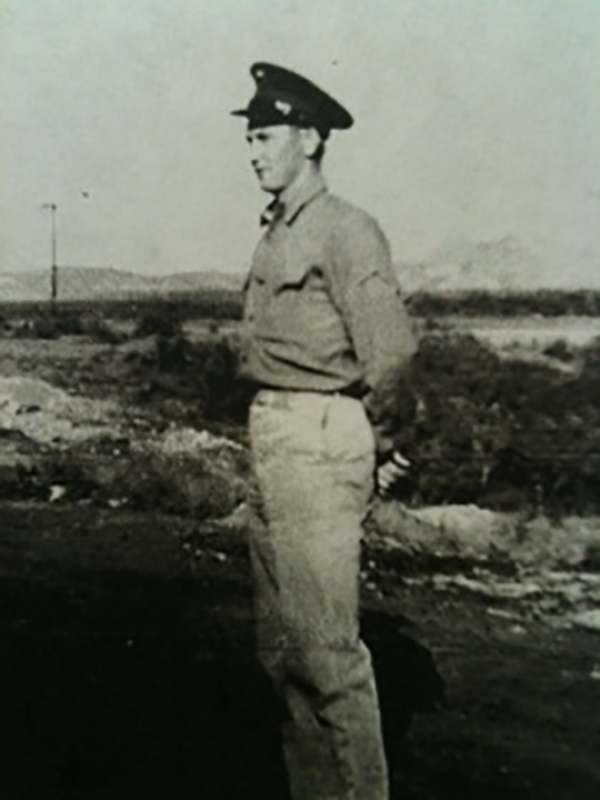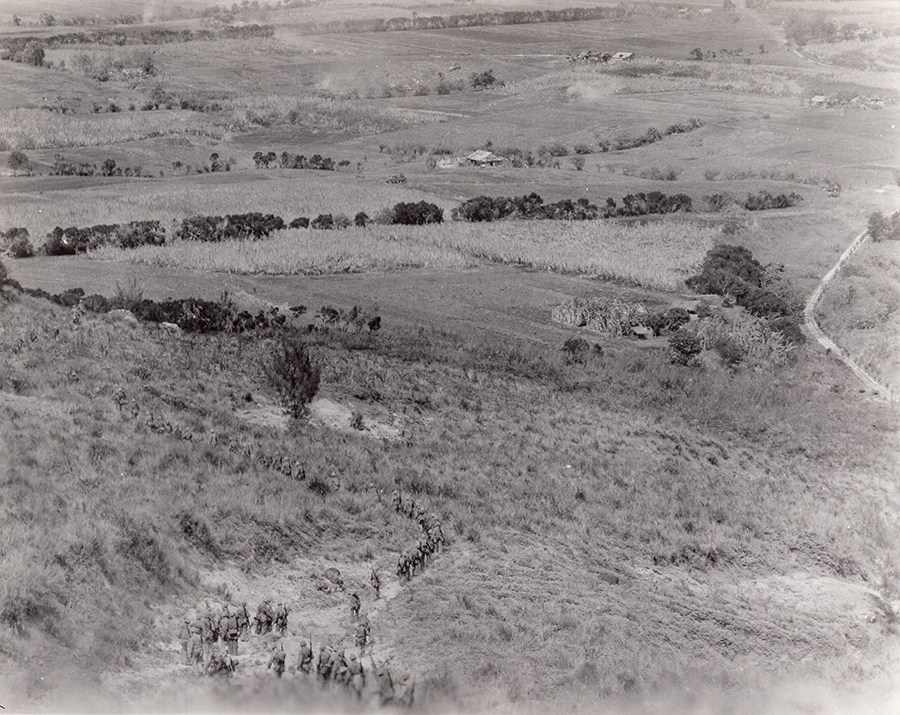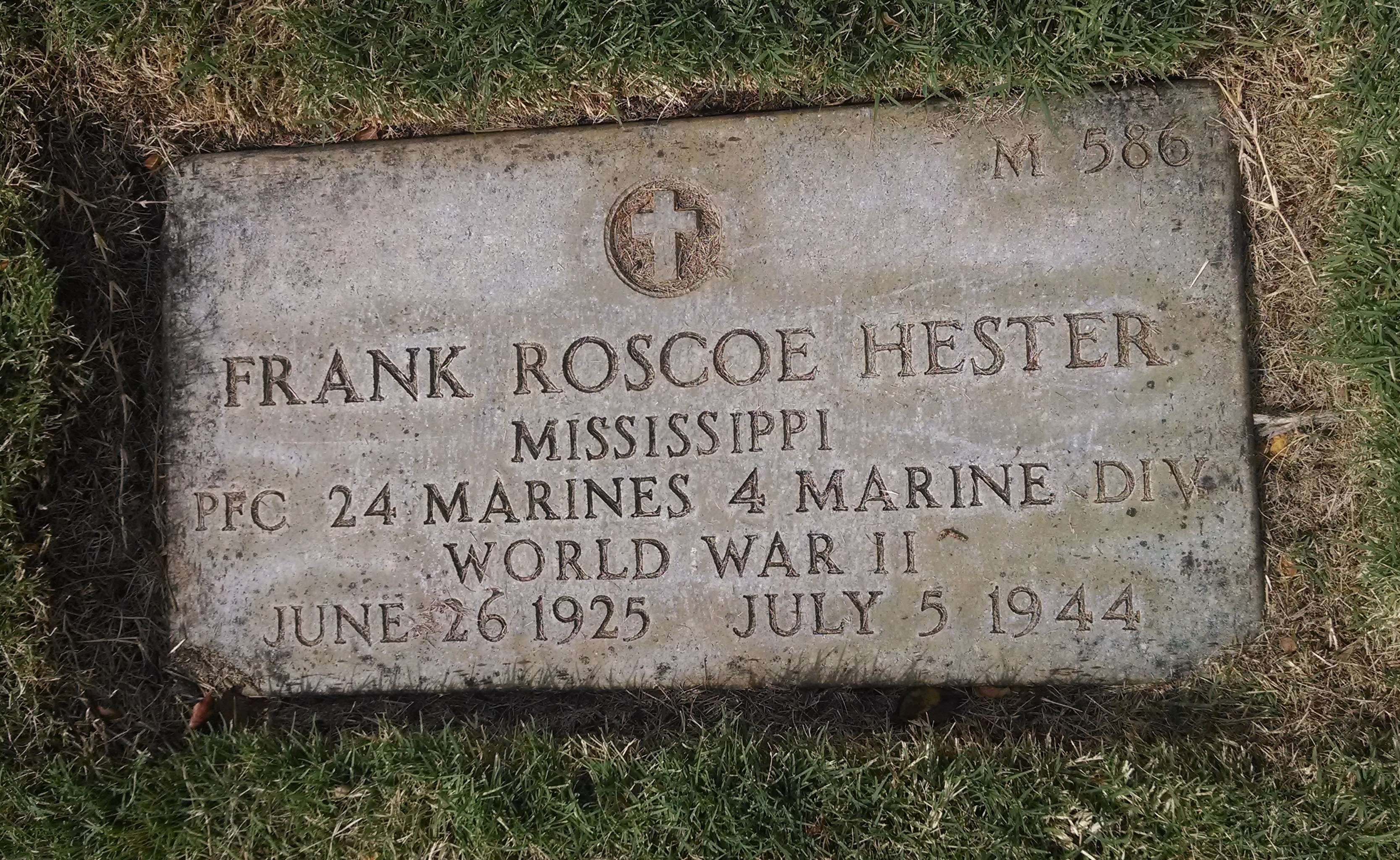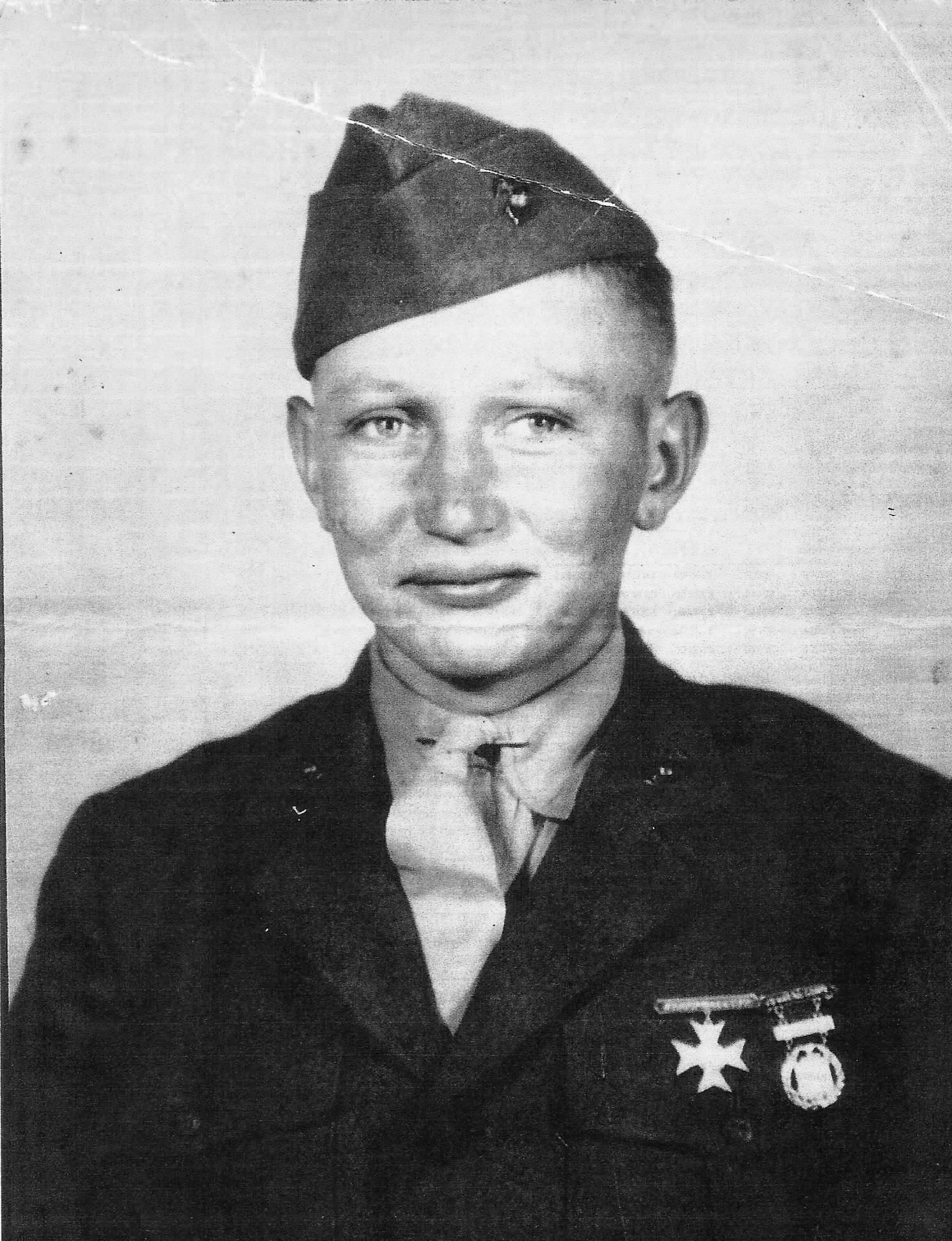| NAME: Frank Roscoe Hester |
NICKNAME: Roscoe |
SERVICE NUMBER: 500927 |
|||||
| HOME OF RECORD: Sallis, MS |
NEXT OF KIN: Mother, Mrs. Ruth Hester |
||||||
| DATE OF BIRTH: 6/26/1925 |
SERVICE DATES: 2/16/1943 – 7/5/1944 |
DATE OF DEATH: 7/5/1944 |
|||||
| CAMPAIGN | UNIT | MOS | RATE | RESULT | |||
| Roi-Namur | A/1/24 | 745 | PFC | ||||
| Saipan | A/1/24 | 745 | PFC | KIA | |||
| INDIVIDUAL DECORATIONS: Purple Heart |
LAST KNOWN RANK: Private First Class |
||||||
Frank Roscoe Hester was born on 26 June 1925, the seventh child of Jim and Rhonda Ruth Hester of Muscadine, Alabama. Shortly after his birth, the Hesters moved to Mississippi, alighting first in Webster County and finally settling in the tiny community of Newport. It was a decidedly rural environment – the nearest town, Sallis, had a population of less than three hundred – and Roscoe, as he was called, grew up working on the family farm. The Hesters grew corn, cotton, and peas; in the mornings, Roscoe would go out to milk and feed the cows. There were plenty of helping hands – by Roscoe’s tenth birthday, he had 10 siblings – but by the late 1930s, the family began to split as the older siblings married or moved on. By 1940, Roscoe was the oldest child left on the farm, which was then being run by Ruth.[1]

At least one of the Hesters felt the call to serve the country – or at least see more of the world than Attala County. Joseph Hester, known as “Joe Lee” to his family, made the 90-mile trip to Jackson and enlisted in the Marine Corps in August of 1940. He was immediately off to California for boot camp, then a billet with the 8th Marines in San Diego. In 1941, as Roscoe was finishing up the seventh grade, Joe Lee joined the 6th Marines and sailed off to Iceland. The Hesters would have followed the country’s path to war with eyes fixed firmly on Europe; Joe Lee’s regiment was intended to serve as a garrison, but would also be in prime position to act as an advance expeditionary force. All anticipated that if war came, the 6th Marines would recreate their heroic exploits of the Great War, once again on the fields of France.
Then Pearl Harbor was attacked, and American attention swung towards the west. Joe Lee’s regiment redeployed to the California coast, and then headed out into the Pacific. Harvey Hester joined the Army in June of 1942; Floyce Hester followed in October. Roscoe surely wanted to be in uniform, too, but he was still underage. He finished grammar school in the summer of 1942 and went back to working the farm – likely feeling that his 18th birthday would never come.
He would not have to wait that long. In February of 1943 – as Sergeant Joe Lee Hester and G/2/6 were winding up the Guadalcanal campaign – the Marine Corps announced they would accept “a limited number of 17-year-olds… deferred until a call is made for them to enter training.” Roscoe leaped at the chance; on 17 February 1943, he and nine other Mississippi teenagers passed their physicals in Jackson and were sworn in to the Corps.[2] Full of pride, Roscoe headed home to await the call to active duty. It would be three long months before his orders arrived. At 10:09 in the morning of 26 May 1943, Roscoe Hester boarded the Tri-State Bus to Jackson, embarking on the first leg of a journey that would end at the Marine Corps Recruit Depot in San Diego, California.
Boot camp agreed with Roscoe. Although young, he was fit from years of farm work; he tipped the scales at nearly 170 pounds and stood over six feet tall. On the rifle range, he rated sharpshooter and cheered the monthly $3 pay bonus that came with the silver cross badge. After infantry school at Camp Elliott, Private Hester was assigned to Company A, First Battalion, 24th Marines as a rifleman. He joined his new outfit on 26 August 1943, three months after leaving home.

Private Hester spent the remainder of 1943 training with the 24th Marines – amphibious exercises, swimming courses, conditioning hikes, and tactical problems out in the California hills. He must have been more worried than most when news of the Tarawa bloodbath reached Camp Pendleton – Joe Lee fought there, but survived without injury – and probably hoped to get home for Christmas, but was not one of the fortunate few to receive a furlough. He had reason to celebrate on New Year’s Day: the promotion list was released, and Roscoe became a Private First Class. Combat was coming, and he was likely ready to put his sharpshooting skills to good use.
He got his chance at Roi-Namur. The details of how Roscoe fared in his first battle are not known; he made it through without being wounded, and even picked up a Japanese parachute from the airfield on Roi as a souvenir. His part in the action lasted less than two days, but they garrisoned the island for a week and Roscoe almost certainly had to help clean up the battlefield – including burying hundreds of dead men. Nobody was sorry to see the Marshall Islands vanish over the horizon as the 4th Marine Division headed for its new base at Camp Maui.
Just four months later, PFC Hester was back aboard a transport ship – the USS Calvert – heading for another battlefield. He landed on Saipan on 15 June 1944, and was immediately subjected to new and terrifying experiences – enemy artillery fire, patrolling ruined towns, Japanese infiltration tactics, and a battlefield full of civilians fleeing one side or the other. He would have lost friends in action, too; unfortunately, it is not known who his close buddies were, or what platoon he was in, but the casualty rate in his company was terrifyingly high.
Roscoe had one lucky break on Saipan. D+11 – 26 June 1944 – was his nineteenth birthday. His battalion was off the lines, in reserve on the Kagman Peninsula. The Japanese made no serious attempts to defend this area, with its wide open plains and tiny villages, and so it was spared much of the devastation wrought on the rest of the island. Elaborate fortifications stood near the shoreline, but their apertures all pointed out to sea, ready to repel an amphibious assault that never came. Marines toured the bunkers and pillboxes, collected souvenirs from abandoned civilian buildings, and even had a chance to swim in the warm water – their first chance to clean themselves since the landings. To top off the red-letter day, fresh supplies arrived from the quartermaster, and the Marines were able to shave and brush their teeth.[3] They packed up their gear before dawn the next day and headed for the hills.
Roscoe would remember that birthday for the rest of his life, for it was the last he would see.

PFC Frank Roscoe Hester survived nineteen days of battle on Saipan. The twentieth dawned hot, as usual, and promised to be much the same as many before: a general attack to the north, advancing until they ran into the enemy, then fighting it out over a series of ridgelines and caves. Most Marines would be OK – they almost always prevailed – but not all would survive, and it was anyone’s guess whether a day would be a Bad One or a Good One.
July 5 turned out to be a Bad One. Mortar observers spotted a group of civilians struggling through a bombardment to reach American lines; once brought in, they told of families and friends held in a cave by Japanese guards. A tall lieutenant from the mortar section, 1Lt. Philip E. Wood, Jr., asked for volunteers to help rescue the trapped people; a few Marines and a corpsman stepped forward. The patrol moved out, and a few minutes later there came a ripple of small-arms fire – mostly Japanese. They had walked into an ambush; the lieutenant was mortally wounded and a sergeant was dead. A rescue mission quickly set out and found themselves engaged in a brisk skirmish with a sizable group of Japanese. An observer noted that “a dozen men were riddled” before the ambush was finally broken.[4]
PFC Frank Roscoe Hester was shot during the initial ambush or in the rescue attempt; he was “found dead in the field” with a bullet hole in his back.[5] Stretcher bearers carried his body back to the battalion area and confirmed his name using his identification tags. Friends said goodbye quickly; they advance was under way and there was little time for mourning, He was placed with care, but little ceremony, aboard a vehicle headed for the rear, alongside the bodies of Lt. Wood, Sergeant Arthur Ervin, Technical Sergeant Arnold Richardson, PFC Davis Kruse, and PFC Larry Knight.

They were all buried the following day. Roscoe was laid down in Grave 824, Row 3, Plot 4 of the 4th Marine Division Cemetery; a marker with his name was placed at the head. His was only one of thousands of graves on Saipan, but he probably had one regular visitor. Once the fight for Tinian was over, the 2nd Marine Division encamped on Saipan – and Joe Lee Hester had plenty of time to visit his little brother’s grave.
Rhoda Ruth Hester received the telegram about Roscoe’s death in July of 1944; condolence letters from his officers soon followed. She learned she was entitled to his Purple Heart and campaign medals, along with the payout from his life insurance policy. Parcels began to arrive, containing her son’s personal effects. In December 1944, Ruth signed for a package of Roscoe’s letters, snapshots, two pencils and a Waterman pen; in July 1945, she received his wallet containing a dime and twelve more pictures. The largest delivery, shipped in August 1945, contained the last of his earthly possessions: a belt and a Red Cross sweater, toiletries, writing paper, and a package of Grainger tobacco. Packaged with these effects was the Japanese parachute – once a treasured souvenir of adventure overseas, now a moldering piece of fabric in a nondescript box.[6]
Frank Roscoe Hester is buried in the National Memorial Cemetery of the Pacific, Section M Grave 586.

[1] According to the 1940 census. It is not known what became of Jim Hester; the census lists Ruth as “widowed” and she signed Roscoe’s enlistment papers as “the mother and only surviving parent.” However, family trees accessed for this biography suggest that Jim died in 1961 and was not in touch with his family.
[2] “Marines Enlist 10 Mississippians,” The Clarion-Ledger (Jackson, MS) 17 February 1943. The seventeen-year-old volunteers were assigned service numbers starting with 500000; Hester’s number was 500927, indicating he was one of the earliest to enlist under this program.
[3] Frederic A. Stott, Saipan Under Fire(Andover: Frederic Stott, 1945), 14.
[4] Ibid.
[5] Frank Roscoe Hester, Official Military Personnel File.
[6] Ibid.

Pingback: Lost On Patrol: PFC Davis Vernon Kruse – First Battalion, 24th Marines
Pingback: Lost On Patrol: PFC Lawrence Elmer Knight – First Battalion, 24th Marines
Pingback: Lost On Patrol: TSgt. Arnold Ross Richardson – First Battalion, 24th Marines